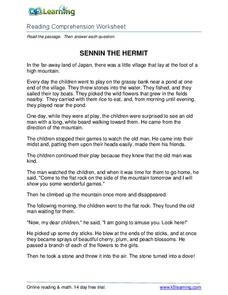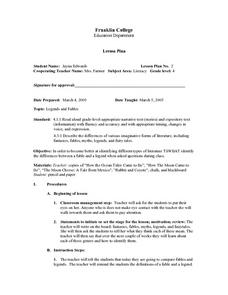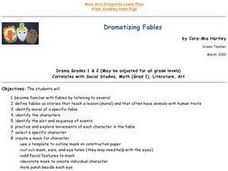Curated OER
Folktales: Fables
Students access a variety of resources on the Internet regarding folktales, fables, tall tales, and fairy tales. They read and compare/contrast the elements of fables, and complete various handouts.
K5 Learning
Sennin the Hermit
Introduce learners to the magical Japanese hermit named Sennin with a reading response activity. As fifth graders finish the story of Sennin and his mystical powers, they answer four short-answer questions.
Curated OER
Storytelling
Students explore the origins of folktales, fairytales, myths, legends, fables, and folktales in the ten lessons of this unit. A storytelling festival is held to feature the results of the variety of activities presented in the unit.
Curated OER
Legends and Fables
Fourth graders identify and discuss the differences between legends and fables. They define fable and legend, then as a class take turns reading our books. Students select two of the stories, and complete a Venn diagram, comparing one...
Curated OER
Knights and Castles and Kings Galore
Fifth graders create a fairy tale story with emphasis on castles. After reading various texts featuring castles and their residents, 5th graders complete a book report project. The book report serves as a springboard to the writing...
Curated OER
I'm a Changed Pig
Introduce your class to fairy tales with this lesson. After reading the fractured fairy tale, "The Three Little Wolves and the Big Bad Pig," third, fourth, and fifth graders write a personal narrative as a response to the fairy tale....
Curated OER
I Hate to Complain but your Cheese Stinks
Students read and discuss the "fractured" fairy tale "The Stinky Cheese Man". They imagine that they are in the fairy tale and write a letter of complaint concerning the Cheese Man and how he stinks up the town.
Curated OER
Tell It to the Judge - Persuasive Essay
Students write a persuasive essay that compares and contrasts a classic fairy tales with a fractured one. They use the writing process to complete and publish the essay.
Curated OER
Slimy Advertising and a Wicked Resume
Students compare and contrast a classic fairy tale with a fractured one. They write an advertisement that would entice a witch and a resume for a frog prince who is hiring. They publish their completed work.
Curated OER
Dramatizing Fables
Students familiarize themselves with fables by listening to several of them. They define fables. They identify the moral of a specific fable. They identify characters, plot and sequence of events. They create a mask of a character in a...
Curated OER
Writing Own Tale
Third graders read The First Strawberries and complete a character chart. In this writing a tale lesson, 3rd graders discuss viewpoints and identify character traits. Students complete character charts and write their own tale about...
Curated OER
The Story Of The Three Bears Retold
In these language arts worksheets, students will read the story of The Three Bears. Students will analyze the tale by Ellen Baumwoll and demonstrate a comprehension of its moral.
Curated OER
Slow and Steady Wins the Race
Students are introduced to the characteristics of fables. They read a fable by Aesop. In small groups, students identify fable characteristics present in Aesop's story and share their observations with the class.
Curated OER
Goldilocks and the Three Bears
Students print out the pictures of bears to retell the story of Goldilocks and the Three Bears. In this fable lesson, students use the bears to retell the fable story.
Montana State University
One Mountain, Many Cultures
Americans may think of Mount Everest as a region dedicated to adventurous hikers, but many cultures have flourished there! Learners read informative books, watch videos, participate in classroom discussion, analyze folk tales, and...
Curated OER
Stories of Nepal
Students explore folktales and fairy tales from Nepal to help them understand the Nepalese culture, and to compare the stories to the ones the students may know. After reading the stories, students consider what rural life is like in...
Savvas Learning
Verbs: Future
As part of their study of future tense verbs, language learners engage in activities, read fables, and sing songs. The 25-page packet includes detailed lessons, worksheets, graphic organizers, and answer keys for assessments.
Curated OER
Nibble, Nibble, Little Mouse
Students complete activities to analyze points of view in different texts. In this point of view lesson, students read Hansel and Gretel and The Magic Circle and discuss the points of view. Students choose a character from the story and...
Curated OER
Tales From Around the World
Students read stories. In this culture lesson, students read stories from different regions around the world. Students look for each region on the map and listen for interesting cultural details in the story. Students then discuss the...
Curated OER
Tell Me a Whopper!
Sixth graders investigate tall tales as a literary genre. They listen to a number of tall tales to discover how exaggeration is used as a story element. They write and publish a tall tale using word processing software. They illustrate...
Curated OER
An Unfinished Tale...
Challenge your writers to compose a proper ending for the short story "The Talisman." Class members start out by either listening to or reading the first nine paragraphs of the story. The rest is up to them! Encourage kids to resolve the...
Curated OER
The Stinky Cheese Man and Other Fairly Stupid Tales
Sixth graders demonstrate the ability to process and evaluate content from a variety of sources and apply comprehension skills to the material read. They organize information for practical use and design and develop an informational...
Curated OER
Language Arts: A Hoe-Down Wedding Invitation
Students write wedding invitations for the fairy tale, Bubba, the Cowboy Prince. Once they assess the components of the original Cinderella story, they compare and contrast it with the fractured fairy tale. Students decorate their...
Curated OER
Personification Stories
Students create a clay object in which they are to personify. They use their own personal experiences to help the viewer imagine what it would be like to be that particular object. They also watch videos of fables to help them with...

























